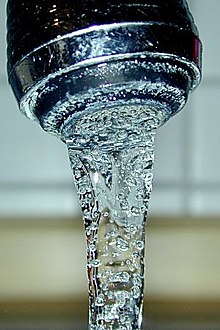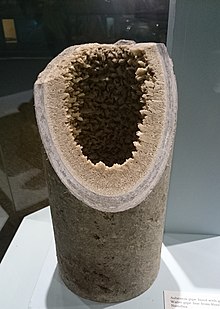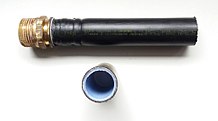Water pipe
A water pipe is a technical system for transporting water to places where it is not naturally available.

Basics
Water pipes for the water supply are an important part of a civilization , because the supply of fresh water reduces the risk of diseases due to poor hygiene. In addition, irrigation plays a central role in agriculture in many regions . In addition to the supply of water, a functioning sewage system is important for this, and drainage in wet areas .
An open water pipe is a canal . In flat terrain, water pipes can be built as water ditches , in more mountainous terrain more extensive construction measures are necessary, such as water tunnels and aqueducts (water bridges), one then expressly speaks of water pipes . In the modern water supply of industrialized countries, open systems only play a subordinate role, pressure tunnels and pressure lines are predominantly used. In the agricultural sector of subtropical countries, however , sophisticated canal systems for irrigating the fields (especially when growing rice ) are common practice.
When the water pipe was used, the wells , which were often the only source of drinking water, lost their importance. These wells were also used to fight fires . However, the largest extinguishing water reservoir was mostly a fire fighting water pond . The presence of the water pipe meant that fire fighting could be carried out much faster and with less effort by drawing water from hydrants . In large areas of Africa, Asia, South America, but also partly in Eastern Europe, the scoop well is still the only way to supply water.
Historic water pipe systems


The oldest records about structures for water pipes come from the time of the Egyptian Pharaoh Ramses II , i.e. approx. 1300 BC. The Romans were also known for their extensive aqueducts . In Pergamon , a pressurized water line already existed. Even the irrigation system of Turpan in China is of great antiquity. The Inca city of Machu Picchu was supplied with water via masonry canal connections. In the Middle Ages wooden pipes were that Pipen or Röhrfahrten used. A line made up of drawbars , several meters long, slender, axially drilled out wooden poles, which supplied the hut at Grünen See , Styria, was only replaced by a plastic line around 1990.
In addition, complex, ancient peasant canal systems can still be found in drier mountain regions:
- Suonen or Bissen in Valais, Switzerland
- Münstertal and the Flims landslide area ( Canton of Graubünden , Switzerland)
- Oberinntal (Tyrol, Austria)
- Waale im Vinschgau (South Tyrol, Italy)
- Aosta Valley (Aosta Region, Italy)
- Wuhre in the Black Forest
- Levadas in Madeira
The last large water pipes built with aqueducts include the Vienna high spring water pipes from 1910.
Drinking water pipes in buildings


In new buildings today, drinking water pipes are laid in pipelines with small nominal widths ( diameters ) that typically withstand a pressure of at least six bar and are practically maintenance-free.
Today, water pipes in buildings essentially consist of
- the house connection with water house entry and initial shut-off ,
- a water meter and the drinking water filter,
- various pipelines within the house with pipes , fittings , fittings and tap fittings ,
- possibly from pipe supports , provided the pipe is laid freely outside the house walls.
used material
The requirements for the materials are laid down in numerous technical rules from DIN and DVGW . The products marked with the abbreviation "DVGW" are used in drinking water installations.
Prolonged stagnation of drinking water in non-DIN-DVGW-certified pipes and especially in fittings can lead to contamination of the water with undesirable substances. After several hours of standstill in the line, water should therefore first flow off for a few seconds before it is used for drinking or cooking purposes. It can be used immediately as utility water, i.e. for washing or watering flowers.
lead
Pipes made of lead may no longer be used in Switzerland since 1914, in Germany since 1973 and in Austria since 1983, but some of them are still in the old stock. The release of lead into the water can be harmful to health.
While the free flowing and non-stagnant water was able to comply with the limit values for lead until the amendment to the German Drinking Water Ordinance in 2001, this is often no longer the case when the new limit values come into force. All pipelines should therefore be replaced as a precaution.
Certain brass alloys used to make faucets contain small amounts of lead, as this makes them easier to work with. If water is left in the fittings overnight, it will absorb small amounts of lead, which under certain circumstances may exceed the limit value.
Galvanized steel pipe
Tubes made of galvanized steel tubing were generally used in sanitary , heating and air conditioning technology in the form of very robust, medium-weight and heavy threaded pipes according to DIN EN 10255, which were screwed to the corresponding fittings using Whitworth threads . The tubes are available up to a size of 6 inches. From 2 inches, however, flange connections are preferred .
Depending on the composition of the minerals in the water in combination with oxygen , a protective oxide layer usually forms on the zinc layer of the pipes.
If the water is heated above 60 ° C, however, the oxide layer can become chemically unstable, whereby first the zinc layer and then the steel corrodes . Galvanized pipes are therefore no longer used for hot water and circulation lines.
In contrast to most of the other materials used, specially galvanized pipes can already start to calcify when the water hardness is medium . Again, this depends on the composition of the water. Likewise, hot water pipes are again particularly affected by limescale deposits, the original cross-section of which in extreme cases is reduced to a small opening within a few years. This is often noticeable in the aerators of the mixer taps, which have to be cleaned of small lime lumps on a regular basis and become clogged especially when the deposits have been loosened during repair work on pipes and connecting parts.
For several years now, thin-walled galvanized precision steel pipes have been used in connection with clamp fittings for heating installations , which installers colloquially call "carbon steel pipes". Under no circumstances should these be used for drinking water installations, as the thin zinc layer on the inside of these pipes can be quickly removed by corrosive water. In addition, condensation often forms on the outside of cold water pipes in summer, which after a few years can lead to the pipes rusting through from the outside if they are not coated or provided with a vapor-tight cover. These pipes are similar to stainless steel pipes, which are very well suited for water pipes and which are also used together with press fittings. Carbon steel pipes and fittings can usually be recognized by their red imprint, while those made of stainless steel usually have a black imprint.
Copper pipe
In most German supply areas, copper water pipes can be used without hesitation. As with galvanized pipes, a protective oxide layer usually forms on the inside.
In almost 10% of the households supplied, copper pipes should not be used due to the composition of the water. According to DIN 50930 Part 6, copper tubing can be used if the analysis data sheets of the water supplier indicate that either the pH value is above 7.4 or that the pH value is between 7.0 and 7.4 and at the same time the TOC value is less than 1.5 mg / l (which corresponds to unusually clean water). Otherwise pitting corrosion can occur.
In case of doubt, it is advisable to ask the pipe and fitting manufacturers for an interpretation of the values published by the waterworks, as not every water supply company sees itself in a position to make a clear recommendation.
If labor costs play a decisive role, the time-saving connection technology using press fittings made of copper and gunmetal is usually used today, while the pipes are otherwise still connected with capillary soldering fittings made of copper, gunmetal and brass. Drinking water pipes up to a dimension of 28 mm may only be soft-soldered. Threaded transition fittings should be made of gunmetal.
Stainless steel pipe
Stainless steel is an inert material and as such can be used not only in drinking water, but also to transport almost any other liquid substance. Today, stainless steel pipe is almost exclusively laid using press fittings. At best, its high price speaks against the use of stainless steel pipes.
Brass and gunmetal
Brass and gunmetal are generally not used as a material for pipes, but for connecting pieces and fittings. Brass is susceptible to stress corrosion cracking, which can occur when a stressed component comes into contact with a corrosive medium such as water. The manufacturer must therefore ensure that the stresses that arise during the production process are relieved by heat treatment and that the hardness of the material remains below a certain guide value.
plastic
Plastic pipes have also been used in house installation since the 1990s . More precisely, it is multi-layer composite pipes in which the water-bearing plastic pipe is encased by one made of aluminum and another made of plastic. Connections are made as press fittings .
Rating
Assuming apartments with the minimum equipment, the drinking water pipe can be roughly dimensioned as follows:
- A cold water pipe with DN 16 and a hot water pipe with DN 13 are sufficient to supply an apartment.
- To connect two apartments, DN 20 is used for cold water and DN 16 for hot water.
- With DN 20 3 to 4 apartments can be connected with hot water. For cold water from three apartments DN 25 is required.
This information applies when using smooth-walled stainless steel, copper, plastic or composite pipes and when equipping the bathroom with a shower tray and a toilet with a cistern.
Labelling
After "KW" was previously used as an abbreviation for pipe marking for cold water and "WW" for hot water , the English abbreviations according to DIN EN 806 Part 1 are now gaining ground in the sanitary industry:
- PWC - Potable Water Cold , i.e. drinking water, cold - color coding: green or blue
- PWH - Potable Water Hot , i.e. drinking water, warm - color coding: green or red
- PWH-C - Potable Water Hot-Circulation , i.e.: drinking water pipe, warm, circulation - color coding: green or purple
According to DIN 2403 , water pipes are generally marked in signal green ( RAL 6032) with white lettering. The colors blue , red and purple are therefore only found in house installations on the handles of fittings or on technical drawings , if there is no risk of confusion with other media. In larger systems, blue , red and violet should not be used to identify pipelines for cold water , hot water and hot water circulation , as DIN 2403 specifies them for oxygen , steam and alkaline lines.
Guidelines
Worksheet W 534, Part 1, No. 2.1 (page 3) of the German Gas and Water Association (DVGW) contains a list of the relevant technical rules for the pipes used in the plumbing and heating industry as well as the associated pipe connectors ( fittings ) and - links.
The protection of drinking water is regulated in DIN EN 1717 and the national supplementary standard DIN DIN 1988-100.
The planning of drinking water installations is carried out according to DIN EN 806 Part 2 as well as the national supplementary standard DIN 1988-200 and the calculation according to Part 3 or DIN 1988-300.
DIN EN 806 Part 3 regulates the execution and Part 4 the operation of drinking water systems.
DIN 1988-7 makes statements about corrosion and stone formation. (This standard will in future be called DIN 1988-700.)
The German Institute for Standardization ( DIN ) has pipe standards for all common pipe materials . For example, DIN 50930-6 deals with pipes made of copper, hot-dip galvanized steel and other metallic materials in drinking water installations.
After individual testing, manufacturers of pipes for sanitary installations receive a DVGW mark. The DVGW mark generally means that the pipe complies with the recognized rules of technology , so that no individual verification according to §20 MBO has to be carried out when it is used. Among other things, labeled pipes meet the requirements of DVGW worksheet W 270 (Multiplication of microorganisms on materials for the drinking water sector - testing and evaluation).
Finally, VDE / VDI regulations may have to be observed during installation .
Other use cases
In addition to drinking water pipes are also used for transporting industrial water uses. For example, with central heating in the house, the thermal energy is transported using hot water. In the past, there were sometimes separate water pipes for drinking and service water in municipalities. Using local groundwater wells in commercial and industrial companies this can definitely save costs. The extraction of naturally soft rainwater from a house roof has the same effect, which can be stored in a cistern, for example to flush toilets, wash clothes and water the garden via its own line.
Car washes use osmosis to circulate purified, softened water.
Water pipes are also increasingly used to transport cold. On the one hand as cooling water that is taken from a body of water for the internal combustion engine of a boat or a thermal power plant. Or cooled by a refrigeration machine , which can be located in the house or, in the case of district cooling, in the city district, and is used for air conditioning. Modern cooling can be done with industrial waste heat, district heating or solar heat via an absorption chiller based on lithium bromide / water.
Extra fine water pipes spray water from fine nozzles over the fruit and vegetables on display in some shops, so that the natural products are not allowed to dry out due to sufficient humidity when the air conditioning in the department store is too dry. Similar systems cool the air in some outdoor dining areas in summer.
Water pipes for irrigation of plants range from an inner diameter of 2 mm (plastic) for drip irrigation into the ground and from 49 mm for detachable sheet metal pipes (HK-Bauer lever coupling up to 194 mm) or the WR system (Wade-Rain up to 150 mm) for irrigation systems for larger ones agricultural areas but also industry, construction sites and mining.
Water pipes for rinsing and cooling water, possibly with additives, are also used for wet grinding, drilling and sawing. Areas of application are dental treatment, knife sharpening, sawing, drilling and milling of metal and concrete, as well as on road rollers, where water also serves as a separating agent against the road asphalt.
heraldry
In Bad Kleinkirchheim's coat of arms, a winding, silver strand of medicinal water leads from the church through the black shield base to the fountain bowl and connects the two in a meaningful way underground.
See also
Web links
Individual evidence
- ^ Franz-Josef Sehr : The construction of the first aqueduct for Obertiefenbach . In: Yearbook for the Limburg-Weilburg district 1999 . The district committee of the district of Limburg-Weilburg, Limburg-Weilburg 1998, p. 274-276 .
- ↑ Heavy metal in the water. Konsumenteninfo AG, accessed on January 1, 2019 .
- ↑ a b Information on pipes in sanitary, heating and air conditioning technology. In: Bosy-Online.de; "Sanitary-heating-air-conditioning information" from central heating and ventilation master builder Bruno Bosy
- ↑ Michael Pohl, Materials and connection technologies in building services installations , IKZ building technology, edition 13/2004, page 34 ff.
- ↑ Statements and reports on damage to components made of brass: [1] , [2] , [3] and [4] , Institute for Loss Prevention and Loss Research of Public Insurers (IFS)
- ↑ Composite pipes: There are three types. In: wallstreet: online. Retrieved October 23, 2017 .
- ↑ Wolfgang Prüfrock: The new DIN EN 806-3: Drinking water pipes easily dimensioned - structure, content, dimensioning example and comparison with DIN 1988-3 , In: IKZ.de
- ↑ Bruno Bosy: Abbreviations in SHK-Handwerk - Sanitär , In: Haustechnikdialog.de
- ↑ Overview of the standards in the publication "Sanitärtechnisches Symposium 2010" of the Central Association of Sanitary, Heating, Air Conditioning
- ↑ HK lever lock coupling: Das Original , Bauer, accessed July 16, 2015.
- ^ System WR (Wade-Rain) ( Memento from July 17, 2015 in the Internet Archive ), Bauer GmbH, accessed July 17, 2015.
- ↑ Bad Kleinkirchheim. In: verwaltung.ktn.gv.at. Retrieved July 2, 2019 .


